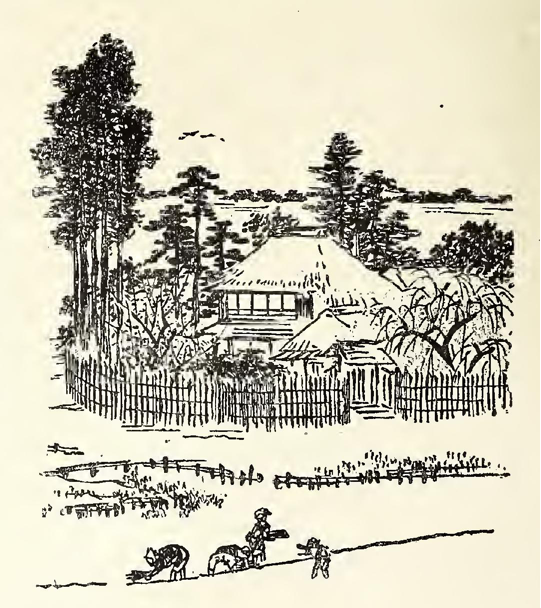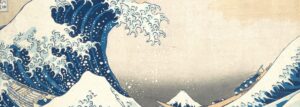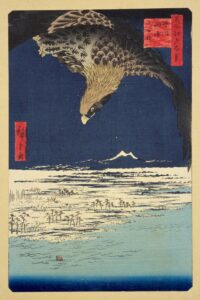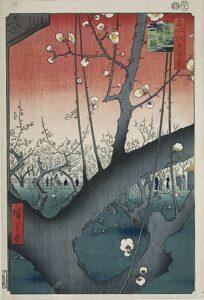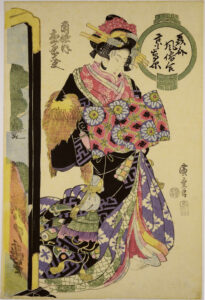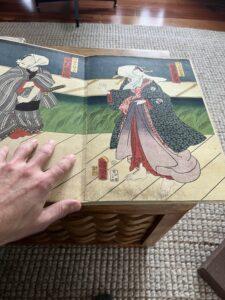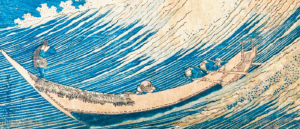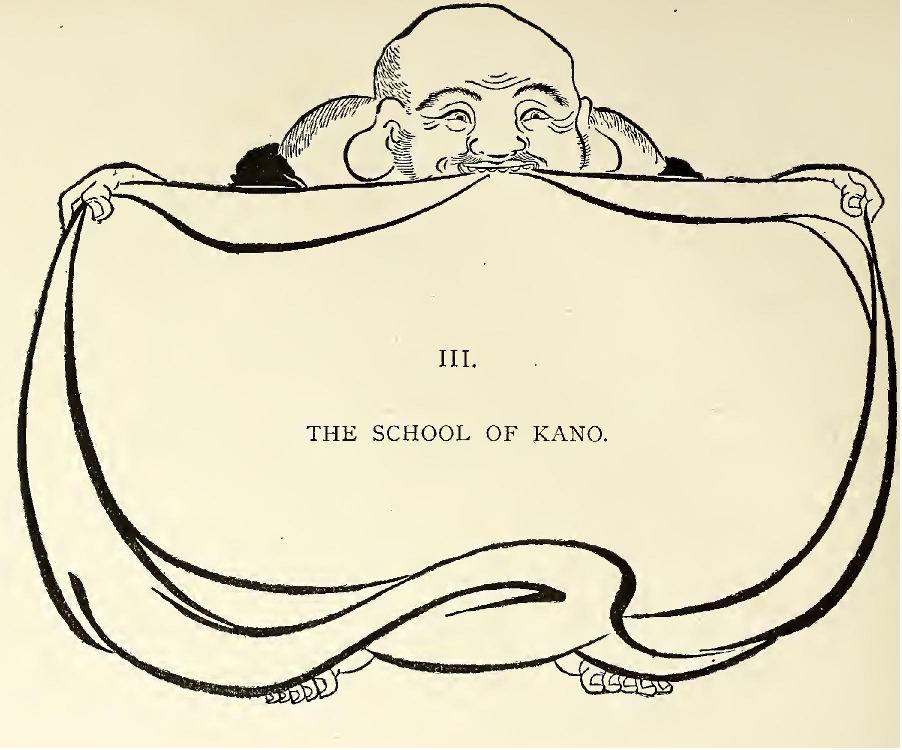 Subsequently to the civil wars occasioned by the rivalries between the Fujiwara, Taira, and Minamoto families, the country passed through various periods of vicissitude. After a century of calm prosperity, fresh storms burst with the advent of the Shogunate under the Ashikaga family. Nevertheless, the last of this name, Ashikaga Yoshimasa, took upon himself the charge of reviving the culture of letters, and the practice of every sort of art. Delighting in the utmost luxury equally with intellectual enjoyments, he built a splendid palace in the neighbourhood of Kyoto, and thither he drew around him eminent artists of every style. Lacquered objects which were perfected at this time, are absolutely unequalled in their beauty, the manufacturing of porcelain became a sort of passion at the Shogunate Court, and to such an extent was it carried, that the leaders of the empire, Yoshimasa at their head, knew no more fascinating amusement than
Subsequently to the civil wars occasioned by the rivalries between the Fujiwara, Taira, and Minamoto families, the country passed through various periods of vicissitude. After a century of calm prosperity, fresh storms burst with the advent of the Shogunate under the Ashikaga family. Nevertheless, the last of this name, Ashikaga Yoshimasa, took upon himself the charge of reviving the culture of letters, and the practice of every sort of art. Delighting in the utmost luxury equally with intellectual enjoyments, he built a splendid palace in the neighbourhood of Kyoto, and thither he drew around him eminent artists of every style. Lacquered objects which were perfected at this time, are absolutely unequalled in their beauty, the manufacturing of porcelain became a sort of passion at the Shogunate Court, and to such an extent was it carried, that the leaders of the empire, Yoshimasa at their head, knew no more fascinating amusement than
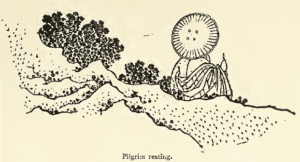
forming with their own hand some delicate vessel destined to be exhibited at the tea ceremonies. These curious entertainments, which have so deeply interested lovers of Japan, were instituted by Yoshimasa. I devoted a chapter to them, in the history of porcelain which I wrote for L’ArtJaponais, by M. Louis Gonse. One of the chief desires of Yoshimasa was to resume in a consistent manner friendly relations with China, which till then had never been more than of an intermittent character. Now is the time to say a word or two about that classic country, which Japanese venerate as the original cradle of their art, in the way that we do honour to Greece as the foundress of the fundamental laws of our æstheticism.
Several of our art critics 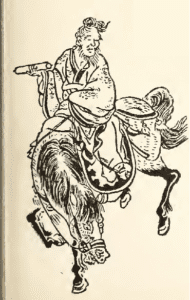 have shown a decided tendency to minimise the part played by China in the growth of Japanese art. Led away by an earnest but exclusive admiration of the latter, they have been unable to admit that so much grace and freshness could issue from a series of productions which are taxed with dryness and formularism.
have shown a decided tendency to minimise the part played by China in the growth of Japanese art. Led away by an earnest but exclusive admiration of the latter, they have been unable to admit that so much grace and freshness could issue from a series of productions which are taxed with dryness and formularism.
But penetrate into some noble dwelling in Japan, and you will be surprised to see there the place of honour decorated by an object of bronze or porcelain admired by all, an old heirloom of the family brought in early times by some hardy explorer in the Land of Marvels.
Whence comes then our disposition to rectify the judgment which the Japanese hold on their own status?
This is easy to see. The happy days when arts were at their greatest perfection in the glorious land of the rising sun, are not yet far distant. They came to an end in the most sudden manner, interrupted by unexpected events, and without giving opportunity for the poison of decadence to do its work. 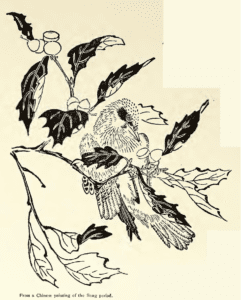 This fulness of bloom, stopped in its prime at the very moment of its greatest beauty, was powerless to leave behind it anything other than that which savours of youth and power.
This fulness of bloom, stopped in its prime at the very moment of its greatest beauty, was powerless to leave behind it anything other than that which savours of youth and power.
It is entirely different in the case of China.
There ages and ages have passed since a wondrous early civilisation gave all which a fruitful soil was capable of producing. The seed since then has dried up gradually, slowly. The tree is still standing, a skeleton with bare arms, 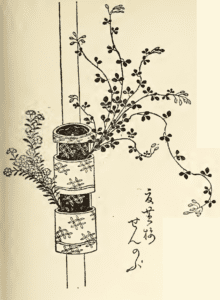 whose leaves have fallen one after another. In truth it has been fruitful, but when we take pains to discover what were its fruits borne in past time, one finds the productions of the latest period which alone may have been preserved at its downfall, full of weakness and foreshadowing total destruction.
whose leaves have fallen one after another. In truth it has been fruitful, but when we take pains to discover what were its fruits borne in past time, one finds the productions of the latest period which alone may have been preserved at its downfall, full of weakness and foreshadowing total destruction.
It is from these productions of old age that China has been judged by our own critics.
As far as this concerns myself, I had some inkling of the real origin of things, and when, in 1880, I visited the capital of the vast Empire, I was inspired with a strong wish to be satisfied on the subject.
Far be it from me to insinuate that before my time no one had dreamt of tracing out these matters. At Pekin, the whole European colony has taken the most lively interest in the ancient art productions of the country. It has almost become a sort of sport, where everyone was searching to lay hands on rare objects. 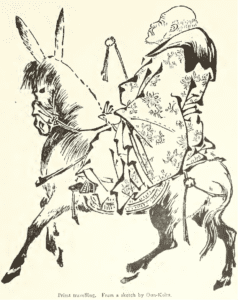 But in this hunt for curiosities, it is but seldom that investigations have been carried beyond curiosity shops. For me other things were necessary. I found out that in the Chinese portion of the town (the other part is inhabited principally by the Manchoos, the conquering race who took possession of the country in the sixteenth century), I knew in fact that in this ancient quarter, a certain street was entirely taken up by booksellers, and sellers of drawings, to which the students came to supply themselves before preparing for the great examinations which are the means for getting various degrees ; a quiet retreat also, whither the old Chinese of cultivated taste were wont to repair.
But in this hunt for curiosities, it is but seldom that investigations have been carried beyond curiosity shops. For me other things were necessary. I found out that in the Chinese portion of the town (the other part is inhabited principally by the Manchoos, the conquering race who took possession of the country in the sixteenth century), I knew in fact that in this ancient quarter, a certain street was entirely taken up by booksellers, and sellers of drawings, to which the students came to supply themselves before preparing for the great examinations which are the means for getting various degrees ; a quiet retreat also, whither the old Chinese of cultivated taste were wont to repair. 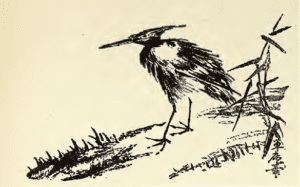 In this place I established the head-quarters of my research. Week upon week saw me ever occupied in turning over great heaps of books and papers. Curious manuscripts and grotesque designs passed under my notice by the thousand. What I was obliged to look over of every kind of document having only the remotest connection with my object in view it is impossible to describe.
In this place I established the head-quarters of my research. Week upon week saw me ever occupied in turning over great heaps of books and papers. Curious manuscripts and grotesque designs passed under my notice by the thousand. What I was obliged to look over of every kind of document having only the remotest connection with my object in view it is impossible to describe.
The harvest reaped was hardly over-abundant, but a small number of ancient paintings gave evidence of the early existence of superior works, certifying beyond doubt the origin of all the qualities of poetry and life- likeness which we were in the habit of considering as the exclusive belongings of Japanese productions.
One cannot be surprised at the rarity of these examples. Besides the fact that the Chinese are very fond of them, and only allow them out of their hands very unwillingly, one must remember also their high antiquity. One hears sometimes the praises spoken of the Ming period (1368-1644) but as a fact,  this was really a witness of undoubted decadence, at least in the art of painting, which had flourished to the utmost extent in the thirteenth century under the dynasty of the Sungs.
this was really a witness of undoubted decadence, at least in the art of painting, which had flourished to the utmost extent in the thirteenth century under the dynasty of the Sungs.
Nevertheless the great tradition was not yet extinguished when in the fifteenth century Yoshimasa looked with favour upon the alliance with the powerful Empire of the Centre ; and this also was the moment when Japanese genius arrived at maturity, and only waited for the proper time to manifest itself through a numerous series of artists of the highest rank. 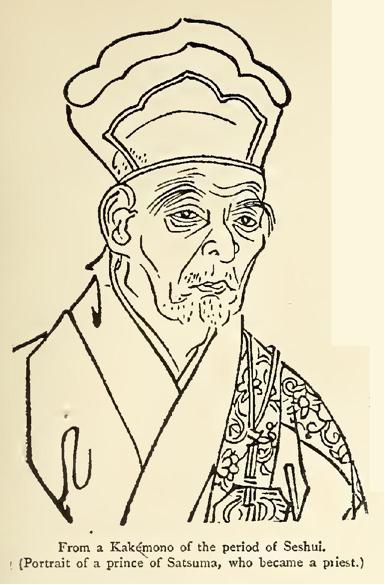 One of them, called Sesshui, could not resist the desire to go and study the old Chinese masters in their native land. There he produced numberless works which have become greatly celebrated. Sesshui was ordered to the court at Peking to paint before the Emperor, and to the great surprise of the sovereign, it is said, he produced upon a piece of silk a dragon sur- rounded with clouds, with a few splashes of his brush filled with Chinese ink.
One of them, called Sesshui, could not resist the desire to go and study the old Chinese masters in their native land. There he produced numberless works which have become greatly celebrated. Sesshui was ordered to the court at Peking to paint before the Emperor, and to the great surprise of the sovereign, it is said, he produced upon a piece of silk a dragon sur- rounded with clouds, with a few splashes of his brush filled with Chinese ink.
Such legends about wondrous feats accomplished by certain popular artists are numerous in Japan. One of the most often repeated, and interpreted by artists of every school, is the following , It is traced, if I mistake not, to Kanaoka, a celebrated painter of the ninth century : —
The rice fields were nightly devastated by some unknown horse, which by day could on no occasion be tracked.
One night, however, it was resolved among the peasants to lie in wait for the animal. As soon as darkness came, it did not fail to make its appearance, but it was swift and artful, showing no willingness to allow its capture. Then a desperate pursuit commenced, which seemed to be without end. In the reproduction of this scene, one sees the horse galloping away, while behind him, in hot haste and breathless, all the people provided with torches, armed with sticks, follow until they can go no further. 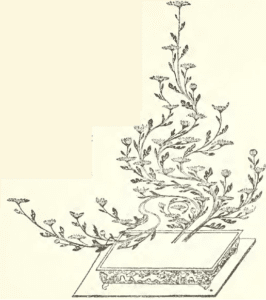 In the meantime the chase grows wilder and more furious ; suddenly, however, the animal dis- appears through a temple door, his hunters follow him, they search everywhere around and cannot find him, until on the wall in a celebrated picture which hangs in its accustomed place, they see the fiery beast, who has just re-entered his frame, entirely covered with foam, and still panting from his frantic race.
In the meantime the chase grows wilder and more furious ; suddenly, however, the animal dis- appears through a temple door, his hunters follow him, they search everywhere around and cannot find him, until on the wall in a celebrated picture which hangs in its accustomed place, they see the fiery beast, who has just re-entered his frame, entirely covered with foam, and still panting from his frantic race.
The horse had been so wondrously portrayed by the artist, and indeed with such an appearance of real life, that he became a living thing, and returned each day to liberty amongst the fields.
But we must return to Sesshui, our traveller artist, who had caused surprise even to the old Chinese masters by the dexterity of his brush. Having stayed some years in the country, he returned to Japan, whither he transplanted the rules he had adopted as his own, and with which he formed a school. Some spirits, notwithstanding, revolted against an entire absorption of national art into the borrowed methods of a neighbouring country. Japan had already arrived at too decided a knowledge of her own power to resign herself entirely without effort. The foreign element might with some advantage be assimilated, allowing a certain amount of native feeling also with it.
Of a fusion thus arrived at a new school was born, for which a glorious future was destined. The artist with genius who first interpreted this sort of regeneration was Kano-Masanobu (1424-1520), founder of the celebrated 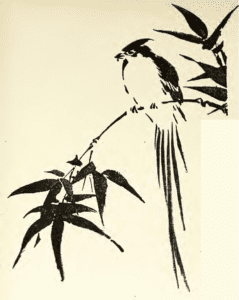 Kano school, which has continued to flourish without interruption to our own times. We reproduce among the separate plates in this number a good specimen of the work of Motonobu, son of this Masanobu, the most celebrated of all the Kano family.
Kano school, which has continued to flourish without interruption to our own times. We reproduce among the separate plates in this number a good specimen of the work of Motonobu, son of this Masanobu, the most celebrated of all the Kano family.
In spite of the pretension of having invented a new style, the art of the Kano school, in the main, proceeds from Chinese originals, whose technique and characteristics it borrows.
The execution is calligraphic, based on the laws applied to writing, which itself (as has been mentioned in these pages on former occasions) is no other than a sort of painting, An artist must be first a writer, for the use of the brush is identical in each case. The perfection in the manipulation of the instrument and the firmness of the touch make one recognise a master workman who should be able to charm the eye by the beauty of his lines, and by the ease and suppleness of his brush work.
The Chinese school and its outcome—the Kano school-—are represented essentially by painting in black and white. The effect is sometimes heightened by the addition of bistre or some other faint tone of colour forming a sort of gradation. But it is Chinese ink which is always chiefly used, and the resources which Chinese and Japanese masters derived from it, are marvellous and unique. The art of representing shades of colours with such simple materials, can be carried to no higher perfection. The most usual subjects are those furnished by landscape, which freed itself little by little from a certain traditional conventionalism which characterised the Chinese decadence ; then again, an extensive series of works is dedicated to fantastic or natural animals, among which the bird is ever the subject of special study, represented lightly and with 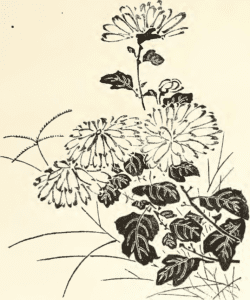 delicacy, or with the wild strength of outstretched wings, peculiar to birds of prey. Saints of all orders find their place in the works of the Kano school ; but instead of mystic beings, throned in ethereal regions, they show us a succession of gods commonplace without exception belonging to the common .round of life, or affecting- asceticism which appears far from austere. Here then, at the close of the sixteenth century, we find Japan in possession of three great schools of painting, each equally flourishing.
delicacy, or with the wild strength of outstretched wings, peculiar to birds of prey. Saints of all orders find their place in the works of the Kano school ; but instead of mystic beings, throned in ethereal regions, they show us a succession of gods commonplace without exception belonging to the common .round of life, or affecting- asceticism which appears far from austere. Here then, at the close of the sixteenth century, we find Japan in possession of three great schools of painting, each equally flourishing.
The BuddhisticSchool, risen from the effects of alliance with neighbouring empires, an ancient school whose formulas of Hindoo origin were handed down intact from the earliest generations. The TösaSchool, national and noble in its sentiment ; under the patronage of a lord of the province of Tösa, one of the Fujiwaras at the time when this powerful family was in its ascendency, and when the frenzy of savage combats was followed by the most chivalrous and noble deeds.
The SchoolofKano, springing from Chinese models, regenerated by the genius of the Kanos, Masanobu, and Motonobu. Japanese art was in its grandest period, at a time when the social state of the country also became steadily peaceable. Under the powerful rule of the great Shogun Iyéyasu, first of the Tokogawa family, civil wars became extinct. A settled quiet was for several centuries to take possession of the country, and would place under a well-planned hierarchy the different factions in the State. Feudalism was strongly established, but it paid regard to the lower classes, and was ardently careful of the artistic tendencies which had taken possession of the entire population. Nowhere was a prince to be found, who, if he did not work himself in some artistic way, was not proud to include among his vassals celebrated artists, who made it their glory to satisfy the refined taste of their master.
In the midst of such artistic fervour certain strong individualities could . 1 not fail to arise, determined by their original creations to avoid the hard rules of the three great schools of painting, which endeavoured to claim all art within their embrace. From these commencements novel manifestations have arisen, whose history should be studied step by step ; but for fear of taking too much space, it is necessary to dismiss till a further occasion the continuation of this review. It will be shown then under what influences Japanese painting arrived at the latest expansion of its decorative beauties with Kôrin and his school ; and also, how in modern days, the minute study of nature triumphs in the Shijo school. It will be my endeavour to demonstrate from what causes the popularart has arisen, which was created by the people for the representation of their particular life. It is this last form of art which will, in fact, lead us to the study of illustrated books and engraving.

